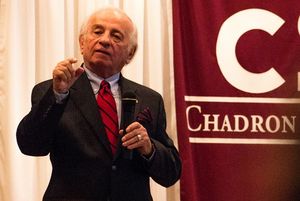Holocaust survivor shares his story on campus

Holocaust survivor Jack Adler shared his story with a large group at Chadron State College this week.
He told about his personal experiences in a Nazi ghetto and several concentration camps.
Adler, 85, lives in Lone Tree, Colo. and has written a book about his years of slave labor and starvation entitled “Y: A Holocaust Narrative,” which is available nationally.
The advice he repeated throughout his presentation was, “Respect everyone as a human being. Don’t perpetuate hate.”
Adler was a featured guest speaker at the CSC Holocaust Education Conference for current teachers and pre-service teachers. He speaks to about 45,000 annually making a total of about million during his lifetime.
CSC students joined the conference attendees to listen to Adler’s remarks.
“I was an eyewitness to a dark age,” he said of the treatment he endured from age 10 in 1939 when the Nazi occupation began in his hometown of Pabianice, Poland until he was 16.
His family, along with others, was ushered, at gunpoint, into an open ghetto in 1940. It was called open because it was not surrounded with barbed wire, or secured by dogs and guards with guns.
The Nazis controlled his family and the myriad of others in the ghetto through fear. He had seen many people shot at point blank range. He and all the other witnesses knew it could happen to them too.
“If anyone objected to anything the Nazis were doing, they were shot on the spot,” he said.
They each had only one slice of bread and one bowl of soup to eat daily for years.
His family’s possessions and apartment, like those of millions of others, were taken by non-Jews.
In 1942, everyone in the ghetto was sorted either into group A or group B. The Nazi soldiers planned to ship out the old, young, weak and sick who were in group A. His younger sister, about nine at the time, was in that group.
He was able to smuggle her back over to his group, group B, one night. He did so by volunteering for clean-up duty in her group’s area and then quietly calling her name. Those in the group repeatedly whispering her name in an effort to help the boy find his sister.
When he found her, he placed her in the large baby carriage he was pushing on his patrol to collect trash left behind by those in group A who had been sent off to their death.
For years, he saw the other five members of his immediate family die from starvation and abuse or by being sent to gas chambers.
One glimmer of hope in the boy’s life took place when he was assigned to work for a Lt. Col. In the Nazi Army, cleaning his office. Adler was surprised when he began to find sandwiches wrapped in waxed paper among the ashes he was cleaning out of the officer’s wood stove daily.
He said after the war was over he tried to find the man and said he would have testified on his behalf at the man’s trial if possible, but the officer could not be found.
In stark contrast to the kindness of this high-ranking officer, a guard along the line where Adler walked to work each day hit him in the back of the neck with the pointed end of a large nail driven through the end of a broom handle. Adler said he still bears the scar from that extremely painful injury.
Adler noted that although religion has bred hate for centuries there are thousands of documented cases of Christian aiding Jews during the Holocaust, at the risk of injury, imprisonment or death,
Speaking of his condition during the Death March which was going on when Adler and his fellow sufferers were liberated by American troops April 27, 1945, he said, “I wouldn’t have lasted another day.” In his book, he stresses that he is not exaggerating this statement. He was weak, and like many others, had accepted the inevitability of death.
After about 90 days of medical treatment and recovery in a hospital, Adler, who was 17 by then, was eventually adopted by a family in Chicago. He married, had children and served in the same U.S. Army which had liberated him.
Following his presentation, Adler answered questions from the audience. In response to a CSC student’s question about why he believes that his life was spared, he said, “So I can be here today and speak to you. I represent six million.”
He also took time to pose for photos with conference attendees and gave audience members a number of “Don’t bite the bait that leads to hate” bumper stickers which he designed.
Category: Campus Events, Campus News

